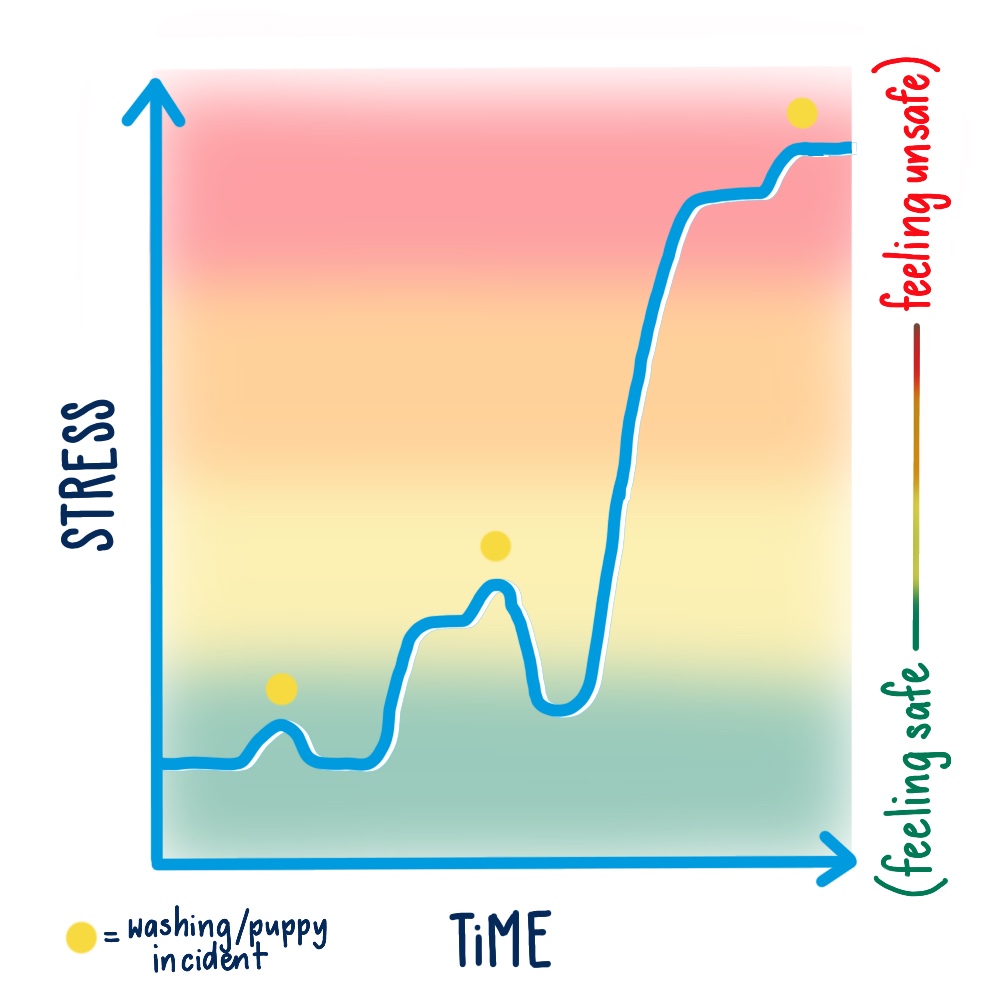
Well we didn’t see this coming did we?! As COVID-19 brings the world to a grinding halt we decided to bump this series of posts to the front of the queue. Anyone else feeling like crawling under a blanket and hiding until the world goes back to normal again?
The truth is, I began putting together bits and pieces for this series last year, well before the series of disasters and calamities that has been 2020! The coping strategies I’ll be sharing over the coming months are designed to help you with any and every difficult situation, from COVID chaos, to grief and loss, eco anxiety, a stressful work situation, or a natural disaster recovery.
Every few weeks I’ll share a few practical, science backed, coping strategies that will help make difficult times more manageable. They’re not magic wands (sorry 🙁 I really wish I could give us all a little bag of magic wands right now!) and they won’t make difficult times disappear. They might not even make them better but they can help increase our capacity to cope. But this post is all about the why and the how of coping strategies because understanding the why of something often makes the actual “doing” of it a whole lot easier. So, in the words of Maria Von Trapp/Julie Andrews, “Let’s start at the very beginning”!
What are coping strategies?
The strategies are designed to help our wonderful friend, ‘Brain’ (If you haven’t met Brain yet, I’d recommend having a quick read of this post). They help the amygdala (a key part of Brain’s emotion department – remember: A for Amygdala which is shaped like an Almond and acts like an Alarm!) to be just a little less jumpy and a little less trigger happy when it comes to sounding that alarm and sending Brain leaping into life-saving Superhero mode. In Superhero mode Brain shuts down all non-essential departments. Well, they’re not essential in an immediate, life-threatening situation but are kind of important in everyday life. You know, things like the thinking, planning, and dreaming department. Oh, and the digestion department, too… 😉 (There’s a more detailed explanation here).
Simply put, they can help you feel safer.
Here’s another way to think about it.
I’m going to tell you a story and get a little bit nerdy by illustrating this story with a graph instead of illustrations!
Meet Armen. Armen is at home doing some washing. Just as he gathers up the wet but clean washing he stumbles, dropping it on the ground. The less than clean ground. His new puppy, spying this potential new plaything, races over and jumps in, muddy paws, shedding fur and all! Armen’s stress levels spike momentarily.
Thankfully, he’s having a good day and isn’t pressed for time. Armen steps back, surveys the mess and laughs. His stress levels drop back to normal as he scoops the puppy up for a quick snuggle (dropping his stress even further) before getting on with the washing. A few days later Armen is running late for work, and his kids still haven’t finished their breakfast.
Now imagine the clean washing, dirty ground, dirty puppy incident happened again. Today it’s no laughing matter. Instead there is yelling. At the dog. At the kids. Thankfully the rest of the day goes smoothly. He has a win at work and his partner surprises him with a special dinner to celebrate.
Stress levels drop back into the “safe” zone.
A month or so down the track, Armen’s father dies suddenly and unexpectedly. His life is thrown into complete turmoil. He is beside himself with grief. The world feels like an unsafe place. Even the most basic of daily tasks, feels overwhelming.
Insert clean washing, dirty ground and puppy scenario. This time he ends up on the ground himself. Curled up in a ball, crying and rocking. The washing stays where it is for another few days and, even then, it’s one of the kids who does it.
It will take everything Armen’s got to get him through the days and weeks ahead – to move back to a place of feeling safe and to have some capacity to cope. That “everything”? That’s his coping strategies.
Let’s see how that all looks in our graph below for a moment.

Armen started off in the green “safe” zone but general life stressors of running late sent him into the yellow zone and saw him yelling and behaving in ways he’d rather not. The death of his father saw him soaring into the red, unsafe zone where any tiny provocation was completely beyond his capacity to cope.
We all have different starting points on this graph. Think of someone living in a refugee camp or a domestic abuse situation. Their starting point might already be in the red, unsafe zone, so any tiny incident can send their Brain into Superhero mode. They might be living permanently in this mode which is exhausting and has a long term impact on both physical and mental health. Their reaction to the clean laundry, dirty ground, dirty puppy incident is going to be totally different to someone whose starting point is in the green, safe zone. From an outsider’s view, their reaction might seem completely out of proportion or unreasonable.
As Armen’s story illustrates, even our own baseline is variable. But as well as triggers that send our stress levels soaring, there are things we can do to bring us back down into the safe zone or to lower our starting point altogether.
Coping strategies are anything that helps to bring that baseline stress back down to a manageable starting point. It’s important to note that not all coping strategies are helpful even if they make life seem easier in the moment – think drug taking, excessive alcohol consumption or self-harming, for example. But, for now, let’s focus on what does help, not what doesn’t (!) but on the understanding that not all the strategies will work for everyone and that I’m trusting you’ll stop using any of them if you find them causing you distress for any reason at all.
What coping strategies aren’t (or “An important disclaimer”)…
While all the strategies I’ll be sharing have been shown to be beneficial to our wellbeing by helping us feel safer or reducing stress, this doesn’t mean they’ll necessarily be effective in treating clinical depression, anxiety or other diagnosable mental health conditions. People in these situations will benefit most from professional support. Please don’t recommend these strategies to anyone as a “cure” for anything or suggest to someone that if they “just tried” these they’d get better.
One (or three!) steps at a time…
In the next post, I’ll share three techniques:
- Name it to Tame it
- Let Nature Nurture
- and Balance the Bias. (They’ll all make sense soon, I promise!)
Why not share all the strategies at once?!
Most coping strategies take practice. Like so many things in life, the benefit comes with time and cumulative use. To be fair, some of these options might also give you an instant boost. But, even then, you have to actually remember to use them! If I write a list of 12 to 15 options all in one post, you’ll struggle to remember what they were, let alone put them into action in the midst of life’s daily challenges. Even more so in the midst of a global pandemic and all the uncertainty it’s brought.
Introducing a few at a time also means I can go a little deeper into each one, explain it more clearly and give you a few more ideas on how to incorporate it into your life, whether that’s in the midst of quarantine isolation, after a traumatic experience, or a stressful life event. And, it gives me more time to write them!
What’s science got to do with it?!
There’s a lot of information floating around in the world these days – hundreds of suggestions on how to handle life flooding your screens every single day. Many of these ideas are just opinions. Of course, there’s nothing wrong with an opinion but you’ve all got enough going on right now, and I don’t want to waste your time. I want to make sure the strategies I give you have the best chance of succeeding and the best way for me to do that is to provide suggestions that have been tried, tested and are trusted by experts in the field. Or, in academic jargon terms, they’re “evidence based.” They’ve been shown to be more likely to be effective at helping keep your emotions at a manageable level and your amygdala from sounding the alarm than would occur just by chance.
My aim is to give you strategies that have sound science behind them and to explain them in a way that you can easily translate into your life right now.
Not every strategy will work brilliantly for every person (research tells us when things work more often than they would just by chance, but I think I’m yet to come across social science research that says this worked in 100% of cases!), so think of these posts as an opportunity to experiment.
Be your own detective!
Over time, you will have built up a personal kit of ‘go-to’ strategies that you know help bring your stress levels back towards the green “safe” zone. To start experimenting and building your kit head over to this post for the first three coping strategies.
Happy experimenting, take care and be gentle with yourself in these unusual times.



Pingback: Three practical, science-backed coping strategies for difficult times - SFAC
Pingback: May News In Brief - SFAC